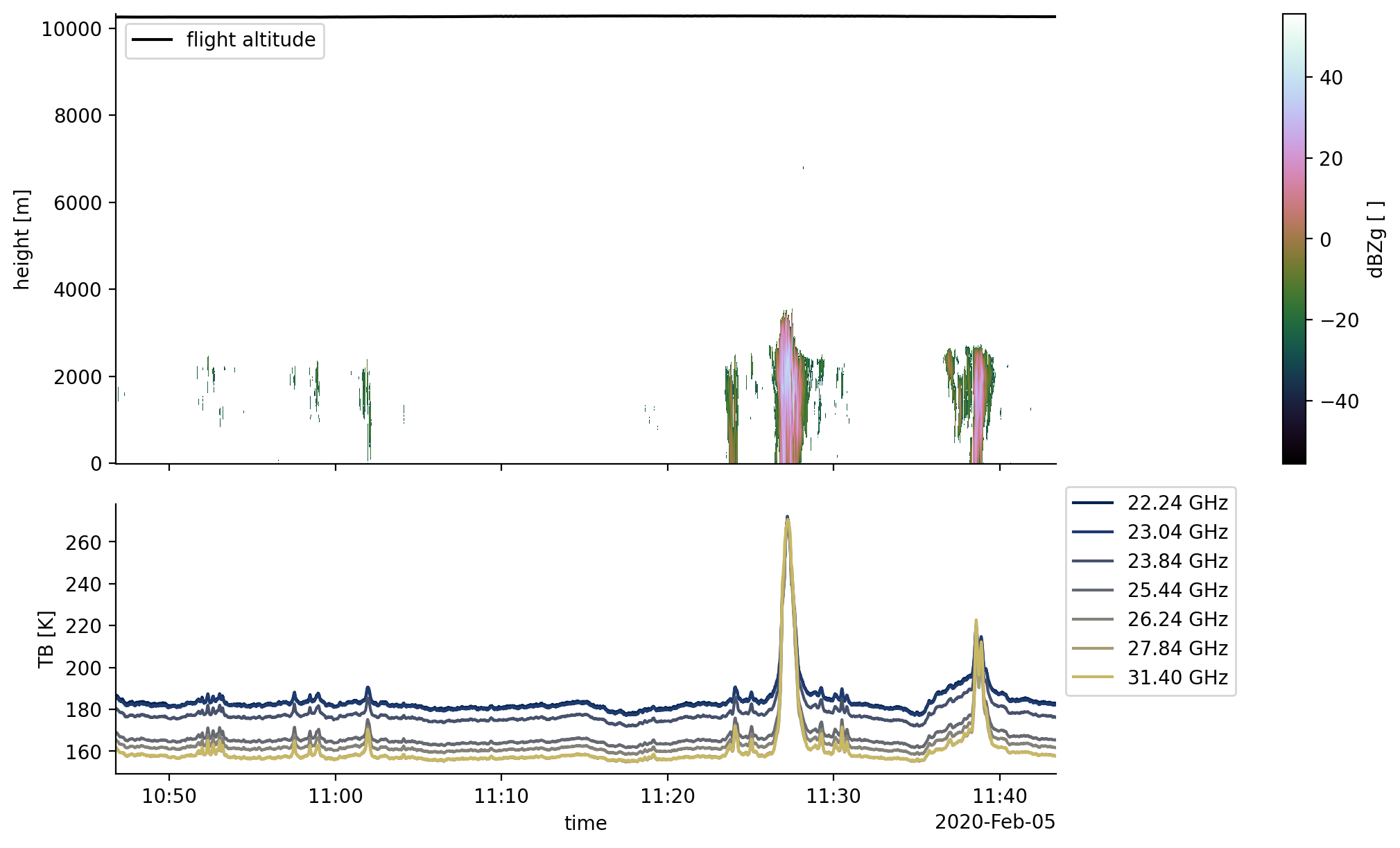HALO UNIFIED dataset#
The HALO UNIFEID dataset is a combination of HAMP radar and radiometer measurements, BAHAMAS aircraft position data and dropsonde measurements, all on a unified temporal and spatial grid.
More information on the dataset can be found at Konow (2021). If you have questions or if you would like to use the data for a publication, please don’t hesitate to get in contact with the dataset authors as stated in the dataset attributes contact or author.
Get data#
To load the data we first load the EUREC⁴A meta data catalogue. More information on the catalog can be found here.
import eurec4a
cat = eurec4a.get_intake_catalog(use_ipfs="QmahMN2wgPauHYkkiTGoG2TpPBmj3p5FoYJAq9uE9iXT9N")
list(cat.HALO.UNIFIED)
['BAHAMAS',
'HAMPradar',
'HAMPradar_cloudmask',
'HAMPradiometer',
'HAMPradiometer_cloudmask',
'HAMPradiometer_retrievals',
'dropsondes']
We can further specify an instrument and a flight and obtain the dataset using
to_dask.
Note
Have a look at the attributes of the xarray dataset ds for all relevant information on the dataset, such as author, contact, or citation infromation.
ds_radar = cat.HALO.UNIFIED.HAMPradar["HALO-0205"].to_dask()
ds_radiometer = cat.HALO.UNIFIED.HAMPradiometer["HALO-0205"].to_dask()
ds_bahamas = cat.HALO.UNIFIED.BAHAMAS["HALO-0205"].to_dask()
/home/runner/miniconda3/envs/how_to_eurec4a/lib/python3.13/site-packages/intake_xarray/base.py:21: FutureWarning: The return type of `Dataset.dims` will be changed to return a set of dimension names in future, in order to be more consistent with `DataArray.dims`. To access a mapping from dimension names to lengths, please use `Dataset.sizes`.
'dims': dict(self._ds.dims),
/home/runner/miniconda3/envs/how_to_eurec4a/lib/python3.13/site-packages/intake_xarray/base.py:21: FutureWarning: The return type of `Dataset.dims` will be changed to return a set of dimension names in future, in order to be more consistent with `DataArray.dims`. To access a mapping from dimension names to lengths, please use `Dataset.sizes`.
'dims': dict(self._ds.dims),
/home/runner/miniconda3/envs/how_to_eurec4a/lib/python3.13/site-packages/intake_xarray/base.py:21: FutureWarning: The return type of `Dataset.dims` will be changed to return a set of dimension names in future, in order to be more consistent with `DataArray.dims`. To access a mapping from dimension names to lengths, please use `Dataset.sizes`.
'dims': dict(self._ds.dims),
Load HALO flight phase information#
All HALO flights were split up into flight phases or segments to allow for a precise selection in time and space of a circle or calibration pattern. For more information have a look at the respective github repository.
meta = eurec4a.get_flight_segments()
We select the flight phase we are interested in, e.g. the second circle on February 5 by it’s segment_id.
segments = {s["segment_id"]: {**s, "flight_id": flight["flight_id"]}
for platform in meta.values()
for flight in platform.values()
for s in flight["segments"]
}
seg = segments["HALO-0205_c2"]
We transfer the information from our flight segment selection to our radar and radiometer data in the xarray dataset.
ds_radar_selection = ds_radar.sel(time=slice(seg["start"], seg["end"]))
ds_radiometer_selection = ds_radiometer.sel(time=slice(seg["start"], seg["end"]))
ds_bahamas_selection = ds_bahamas.sel(time=slice(seg["start"], seg["end"]))
Plots#
We plot reflectivity from the HAMP Radar, the flight altitude of HALO and brightness temperatures from the low-frequency channels along the 22 GHz water vapor line (K band) from the HAMP radiometer.
%matplotlib inline
import numpy as np
import matplotlib.pyplot as plt
import pathlib
plt.style.use(pathlib.Path("./mplstyle/book"))
fig, (ax1, ax2) = plt.subplots(2, 1, sharex=True, gridspec_kw={'height_ratios':(2, 1.2)})
# 1st plot: Radar dBZ and flight altitude
ds_bahamas_selection.altitude.plot(ax=ax1, x='time', color='black', label='flight altitude')
ax1.legend(loc ='upper left')
ds_radar_selection.dBZ.plot(ax=ax1, x='time', cmap='cubehelix' )
ax1.set_xlabel('')
# 2nd plot: Radiometer TB
## select low frequency channels along the 22 GHz water vapor line
low_freq = ds_radiometer_selection.frequency < 32
ds_radiometer_low_freq = ds_radiometer_selection.isel(frequency=low_freq)
## set line colors for 2nd plot
colors2 = plt.get_cmap("cividis")(np.linspace(0, 0.8, low_freq.values.sum()))
ax2.set_prop_cycle(color=colors2)
for frequency, data_radiometer in ds_radiometer_low_freq.groupby("frequency"):
data_radiometer.tb.plot(ax=ax2, x='time', label=f'{frequency:.2f} GHz')
ax2.set_title('')
ax2.legend(bbox_to_anchor=(1,1.1))
None



